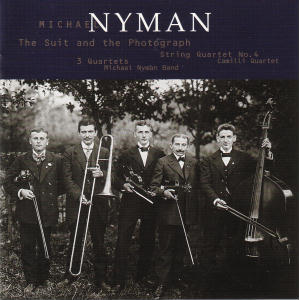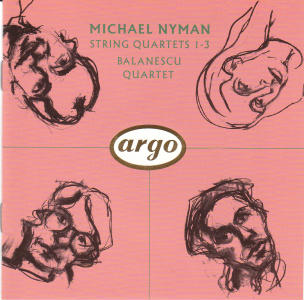Related Research Articles

An overtone is any resonant frequency above the fundamental frequency of a sound. In other words, overtones are all pitches higher than the lowest pitch within an individual sound; the fundamental is the lowest pitch. While the fundamental is usually heard most prominently, overtones are actually present in any pitch except a true sine wave. The relative volume or amplitude of various overtone partials is one of the key identifying features of timbre, or the individual characteristic of a sound.

Michael Laurence Nyman, CBE is an English composer, pianist, librettist, musicologist, and filmmaker. He is known for numerous film scores, and his multi-platinum soundtrack album to Jane Campion's The Piano. He has written a number of operas, including The Man Who Mistook His Wife for a Hat; Letters, Riddles and Writs; Noises, Sounds & Sweet Airs; Facing Goya; Man and Boy: Dada; Love Counts; and Sparkie: Cage and Beyond. He has written six concerti, five string quartets, and many other chamber works, many for his Michael Nyman Band. He is also a performing pianist. Nyman prefers to write opera over other forms of music.

The Carnival of the Animals is a humorous musical suite of fourteen movements, including "The Swan", by the French composer Camille Saint-Saëns. The work, about 25 minutes in duration, was written for private performance by two pianos and chamber ensemble; Saint-Saëns prohibited public performance of the work during his lifetime, feeling that its frivolity would damage his standing as a serious composer. The suite was published in 1922, the year after his death. A public performance in the same year was greeted with enthusiasm, and the work has remained among his most popular. In addition to the original version for chamber ensemble, the suite is frequently performed with a full orchestral complement of strings.

John Luther Adams is an American composer whose music is inspired by nature, especially the landscapes of Alaska, where he lived from 1978 to 2014. His orchestral work Become Ocean was awarded the 2014 Pulitzer Prize for Music.

Franz Schubert's final chamber work, the String Quintet in C major is sometimes called the "Cello Quintet" because it is scored for a standard string quartet plus an extra cello instead of the extra viola which is more usual in conventional string quintets. It was composed in 1828 and completed just two months before the composer's death. The first public performance of the piece did not occur until 1850, and publication occurred three years later in 1853. Schubert's only full-fledged string quintet, it has been praised as "sublime" or "extraordinary" and as possessing "bottomless pathos," and is generally regarded as Schubert's finest chamber work as well as one of the greatest compositions in all chamber music.
Lera Auerbach is a Soviet-born Austrian-American classical composer, conductor and concert pianist.
Variations for Winds, Strings and Keyboards is an orchestral piece composed in 1979 by Steve Reich. The piece is scored for oboes, flutes, full brass, strings, pianos, and electric organs. Variations was Reich's first orchestral piece.

The Suit and the Photograph is a 1998 album by Michael Nyman with the Michael Nyman Band, recorded in 1995. On this album, Nyman is the composer, conductor, and producer, and wrote the liner notes. The album contains two works, String Quartet No. 4 and 3 Quartets. The album is named for its cover photograph by August Sander, which Nyman had associated with the Michael Nyman Band since its inception in 1977. He cites a description of the photograph by John Berger, in an essay of the same title, describing that the suits deform the working class rural men just enough to "undermine physical dignity." Both of the pieces on the album originated in Japan. It is Nyman's second release on EMI and his 33rd in general, but is not designated part of a series, as EMI had done with Concertos. Said Nyman of EMI, "I didn't excite them, and they didn't excite me." Nyman's only further releases on EMI would be the UK edition of Ravenous, featuring remixes by William Orbit, and The Actors, both film scores.

String Quartets 1–3 is a 1991 album by the Balanescu Quartet and the fifteenth release by Michael Nyman. It is the second album of his music on which he did not perform or conduct, though he does provide liner notes. String Quartet No. 3 is built out of Out of the Ruins and became a fixture in numerous Nyman film scores in the 1990s.
Become Ocean is an orchestral composition by American composer John Luther Adams. The Seattle Symphony Orchestra commissioned the work and premiered it at Benaroya Hall, Seattle, on 20 and 22 June 2013. The work won the 2014 Pulitzer Prize for Music and the 2015 Grammy Award for Best Classical Contemporary Composition. In 2019, writers of The Guardian ranked it the 10th greatest work of art music since 2000.
Symphony No. 10 is the tenth symphony by the American composer Philip Glass. The work was commissioned by the Orchestre Français des Jeunes and premiered August 9, 2012, with Dennis Russell Davies conducting the Orchestre Français des Jeunes at the Grand Théâtre de Provence in Aix-en-Provence. The piece had its United Kingdom premiere July 31, 2013 at The Proms in Royal Albert Hall.
Arcadiana, Op. 12, is a 1994 composition for string quartet written by the English composer Thomas Adès. The quartet was commissioned by the Endellion Quartet with contributions from the Holst Foundation.
Notes on Light is a cello concerto by the Finnish composer Kaija Saariaho. The work was commissioned by the Boston Symphony Orchestra and was first performed at Symphony Hall, Boston on February 22, 2007, by the cellist Anssi Karttunen and the Boston Symphony Orchestra under the conductor Jukka-Pekka Saraste.
The Concerto for Viola and Orchestra is a viola concerto by the American composer John Harbison. The work was commissioned by the Saint Paul Chamber Orchestra, the Los Angeles Chamber Orchestra, and the New Jersey Symphony Orchestra with contributions from Meet The Composer and Reader's Digest. It was first performed by Jaime Laredo and the New Jersey Symphony Orchestra under the direction of Hugh Wolff on May 18, 1990.
Absolute Jest is a concerto for string quartet and orchestra by the American composer John Adams. The work was commissioned by the San Francisco Symphony for the orchestra's centennial. Its world premiere was given at the Louise M. Davies Symphony Hall on March 15, 2012, and was performed by the St. Lawrence String Quartet and the San Francisco Symphony under the direction of Michael Tilson Thomas. However, after the premiere Adams heavily re-wrote the beginning of the piece; this revised version of Absolute Jest was first performed in Miami Beach on December 1, 2012, by the St. Lawrence String Quartet and the New World Symphony under the composer's direction.
Towards the Horizon is the second cello concerto by the Finnish composer Einojuhani Rautavaara. The work was commissioned by the Minnesota Orchestra under the direction of Osmo Vänskä. It was first performed by the cellist Arek Tesarczyk and the Minnesota Orchestra conducted by Osmo Vänskä in Orchestra Hall, Minneapolis, on September 30, 2010. The piece is dedicated to the cellist Truls Mørk, who was originally scheduled to perform the world premiere, but had to drop due to health concerns.
The Flute Concerto is a composition for solo flute and orchestra by the American composer Ned Rorem. The work was commissioned by the Philadelphia Orchestra and was composed between August 2001 and May 2002. Its world premiere was given by the flutist Jeffrey Khaner and the Philadelphia Orchestra conducted by Roberto Abbado at the Kimmel Center for the Performing Arts on December 4, 2003.
The Double Concerto is a composition for violin, cello, and orchestra by the American composer Ned Rorem. The work was commissioned by the Indianapolis Symphony Orchestra and composed between July 27, 1997, and April 1998. It was composed for the violinist Jaime Laredo and the cellist Sharon Robinson, who first performed the piece with the Indianapolis Symphony Orchestra conducted by Raymond Leppard in Indianapolis on October 15, 1998.
John Lely is British experimental composer, improvising musician and curator based in London, UK.
The Concerto for Violin and Orchestra "Eleven Eleven" is the first violin concerto written by American composer Danny Elfman. Co-commissioned by the Czech National Symphony Orchestra, Stanford Live at Stanford University, and the Royal Scottish National Orchestra, the piece premiered at Smetana Hall in Prague, on June 21, 2017, with Sandy Cameron on violin and John Mauceri conducting the Czech National Symphony Orchestra. In 2019, the premiere recording of the concerto featured Cameron with Mauceri conducting the Royal Scottish National Orchestra.
References
- 1 2 Siôn, Pwyll ap (April 2015). "ADAMS: Wind in High Places; Canticles of the Sky". Gramophone . Retrieved February 13, 2016.
- 1 2 Rhein, John von (September 30, 2014). "More delights than duds in MusicNOW series opener". Chicago Tribune . Retrieved February 13, 2016.
- ↑ Huizenga, Tom (January 21, 2015). "John Luther Adams' Ode To Sundogs". Deceptive Cadence. NPR . Retrieved February 13, 2016.
- ↑ "The Best Classical Music Recordings of 2015". The New York Times . December 10, 2015. Retrieved February 13, 2016.